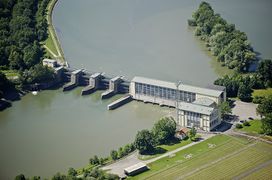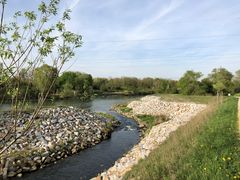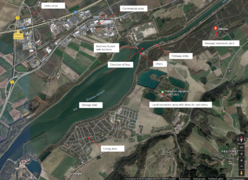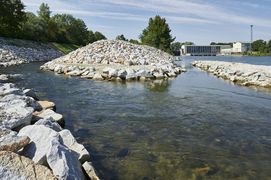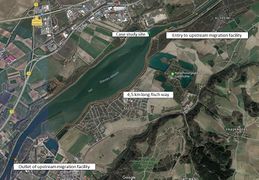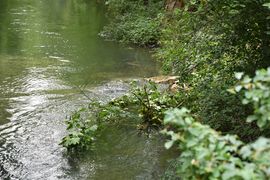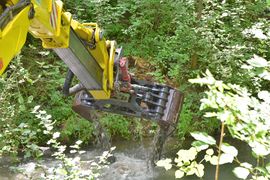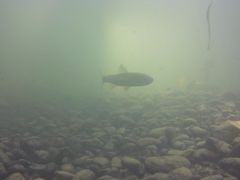Difference between revisions of "Altheim test case"
Bendikhansen (talk | contribs) |
|||
| (53 intermediate revisions by 4 users not shown) | |||
| Line 1: | Line 1: | ||
[[Category:Test cases]] | [[Category:Test cases]] | ||
| − | + | {{Fact box for Altheim}} | |
| − | { | + | {{Relevant SMTDs for Altheim}} |
| − | |||
| − | |||
| − | |||
| − | |||
| − | |||
| − | |||
| − | |||
| − | |||
| − | |||
| − | |||
| − | |||
| − | |||
| − | |||
| − | |||
| − | |||
| − | |||
| − | |||
| − | |||
| − | |||
| − | |||
| − | |||
| − | |||
| − | |||
| − | |||
=Introduction= | =Introduction= | ||
The river Isar, located in the south of Germany, is an Alpine river. It flows from its source in Austria at 1600 m above sea level through the Alps, pre-alpine moorlands and through the city of Munich before entering the Danube river near Deggendorf at 300 m above sea level. With a length of 260 km it is the fourth largest river in Bavaria and the second most important tributary of the Danube in Germany. | The river Isar, located in the south of Germany, is an Alpine river. It flows from its source in Austria at 1600 m above sea level through the Alps, pre-alpine moorlands and through the city of Munich before entering the Danube river near Deggendorf at 300 m above sea level. With a length of 260 km it is the fourth largest river in Bavaria and the second most important tributary of the Danube in Germany. | ||
| − | The catchment area of the Isar covers 8960 | + | The catchment area of the Isar covers 8960 km<sup>2</sup> in the Alps and the Karwendel mountains. The Isar is generally divided into three sections: the Upper Isar, the Middle Isar and the Lower Isar. The Test Case hydropower plant Altheim is located in the Lower Isar, at km 67.2, near the town Altheim. Downstream of the Test Case, 7 additional hydropower plants are located along the Isar. |
| − | The section of the Isar that relates to the Test Case Altheim has a catchment area of 88.2 | + | The section of the Isar that relates to the Test Case Altheim has a catchment area of 88.2 km<sup>2</sup> and is about 73 km long. It has an intern-annual discharge of 163 m<sup>3</sup>/s. Typically the discharge characteristics show high flows and fast floods in spring time during snow melt and rather low flows in winter. It is classified as a waterbody with poor ecological status. |
=About the hydropower plant= | =About the hydropower plant= | ||
| − | The hydropower plant at Altheim, commissioned in 1951, is a block-type hydropower plant and part of a chain of power plants in the Isar. It has an installed capacity of 17.8 MW and a mean annual output of 91.4 GWh. The plant has 4 | + | The hydropower plant at Altheim, commissioned in 1951, is a block-type hydropower plant and part of a chain of power plants in the Isar. The catchment area of this river stretch is about 7.908 km². It has an installed capacity of 17.8 MW and a mean annual output of 91.4 GWh. The plant has a gated weir with 4 bays located on the right of the power house and a head storage volume of 1,980,000 m<sup>3</sup>. |
| − | The normal operating level is at 384.00 m above sea level, in swelling operation it can be lowered by 1.00 m. On average, there are 2 peaks per day, where the flow changes roughly between 50 | + | The normal operating level is at 384.00 m above sea level, in swelling operation it can be lowered by 1.00 m. On average, there are 2 peaks per day, where the flow changes roughly between 50 m<sup>3</sup>/s and 170 m<sup>3</sup>/s with ramps of about 100 m<sup>3</sup>/s per hour or a change of water level between +45 cm/h to - 30 cm/h. |
===Layout=== | ===Layout=== | ||
The area around the power plant is dominated by commercial and living areas on the left side and a popular local recreation area with lakes for swimming on the right side, as well as a sewage treatment plant in Altheim. | The area around the power plant is dominated by commercial and living areas on the left side and a popular local recreation area with lakes for swimming on the right side, as well as a sewage treatment plant in Altheim. | ||
| Line 50: | Line 26: | ||
The dimensioning criteria for the upstream migration facility, which was built in 2015, were the fish species Barbus barbus and Hucho hucho. The fish pass consists of a rough channel for the downstream connection at the entry of the fish pass. It is located on the right-hand side 300 m downstream of the power plant. An existing ditch has been used to facilitate the fish passage over 4.5 km and for providing new hydromorphological structures and habitats in the fish pass. Upstream, a vertical slot connects the nature-like fish pass to the river. This migration facility is always supplied with a minimum flow of 450 l/s which can be extended to up to 800 l/s. | The dimensioning criteria for the upstream migration facility, which was built in 2015, were the fish species Barbus barbus and Hucho hucho. The fish pass consists of a rough channel for the downstream connection at the entry of the fish pass. It is located on the right-hand side 300 m downstream of the power plant. An existing ditch has been used to facilitate the fish passage over 4.5 km and for providing new hydromorphological structures and habitats in the fish pass. Upstream, a vertical slot connects the nature-like fish pass to the river. This migration facility is always supplied with a minimum flow of 450 l/s which can be extended to up to 800 l/s. | ||
===E-flow=== | ===E-flow=== | ||
| − | HPP Altheim is one HPP in a chain of hydropower plants. Usually a minimum flow of 40 | + | HPP Altheim is one HPP in a chain of hydropower plants. Usually a minimum flow of 40 m<sup>3</sup>/s is operated, a full stop of machines is a rare exception. For own purposes, one machine for station supply must always be operated with a minimum of 11.7 m<sup>3</sup>/s. Although the connected small stream Längenmühlbach has an agreed minimum e-flow of 3.2 m<sup>3</sup>/s all year, it is not within the scope of the Altheim Test Case within FIThydro. |
=Research objectives and tasks= | =Research objectives and tasks= | ||
| Line 60: | Line 36: | ||
* Evaluating the maintenance costs of a nature-like fish pass | * Evaluating the maintenance costs of a nature-like fish pass | ||
=Results= | =Results= | ||
| + | Over a total length of about 1.5 km of the natural fish pass 37 different habitat structures have been implemented. The structures mainly consist of dead wood and spawning gravel and were constructed as spawning habitats, juvenile habitats or shelter but also to generally increase the variability in flow conditions. The value of these structures was evaluated from October 2019 to May 2020. | ||
| + | |||
| + | To evaluate the potential ecological value of the measures, five habitat structures were selected and examined by using the underwater cameras „Rollei 525“. Three cameras were placed around the habitat structures and three were placed at the other, unaltered bank. This approach allowed to compare and assess the fish density between the two sides. Furthermore it was possible to compare the five habitat structures with each other on the basis of predefined parameters and to frame potential differences regarding fish density and fish species. | ||
| + | |||
| + | The results show that the habitat structures provide a significant ecological benefit. They offer habitats especially for small fish species such as schneider (Alburnoides bipunctatus) to support their population. Especially the variability between fast flowing areas and flat, flow-reduced sections support the availability of specific habitats for different species. Also it turned out that there are major differences between the habitat structures regarding fish density and the number of fish species. This is probably caused by seasonal variation and preferences, abiotic factors as well as the location and type of habitat structure. | ||
| + | |||
| + | The high velocity and cool water temperature in the fish pass generally support the establishment of a sustainable grayling population. This fact is especially important regarding the threatened status of the grayling and the lack of habitats in the main river Isar. It shows the high water quality and good habitat availability of the fish pass. The fish pass turned also out to be a suitable habitat for ground oriented fish species such as barbel gudgen, zingel or European bullhead. | ||
| + | |||
| + | The criteria for habitat structures adding value to the fish pass do highly vary with the species targeted at. Structures with good flow conditions and clean gravel substrate in combination with the low water temperature showed excellent results for the target species of river Isar. Also the position of the structure is important to avoid deposition of fine sediments and also over a variety of water depths. | ||
| + | |||
| + | The maintenance effort does mainly increase with the length of the fish pass but not with the implementation of the habitat structures. It is important that the fish pass contains the necessary maintenance infrastructure such as ways along to be used by cars and heavy machines to make sure the maintenance works can be done properly. The habitat structures are expected to need a proper refurbishment after a longer time period than analysed in within the project. | ||
| + | |||
| + | =Gallery= | ||
| + | <gallery mode=packed> | ||
| + | altheim_overview.jpg|Aerial view of Altheim dam, power plant, and reservoir (source: Uniper). | ||
| + | altheim_natural_fishway.jpg|Entrance to the nature-like fishway at Altheim (source: Uniper). | ||
| + | altheim_layout.png|Layout of the Altheim powerplant and the surrounding area (source: google maps, Uniper). | ||
| + | altheim_natural_fishway_downstream.jpg|View of the Altheim nature-like fishway from downstream (source: Uniper). | ||
| + | altheim_migration_layout.jpg|Layout of the fish migration system at the hydropower plant Altheim (source: google maps, Uniper). | ||
| + | Altheim structure 1.jpg|thumb|Implementation of rocks to vary flow conditions (source: Uniper. | ||
| + | Altheim structure 2.jpg|thumb|Relocation of gravel as spawning habitat (source: Uniper). | ||
| + | Altheim underwater.jpg|thumb|Underwater picture of fish at one of the structures (source: Uniper). | ||
| + | </gallery> | ||
Latest revision as of 14:02, 21 October 2020
| Fact box: Altheim | |
|---|---|
| Country | Germany |
| River | Isar |
| Operator | UNIPER |
| Capacity | 17.8 MW |
| Head | 8.2 m |
| Inter-annual discharge | 163 m3/s |
| Turbine(s) | 5 Kaplan turbines |
| Detailed report | Click for pdf |
Contents
Introduction
The river Isar, located in the south of Germany, is an Alpine river. It flows from its source in Austria at 1600 m above sea level through the Alps, pre-alpine moorlands and through the city of Munich before entering the Danube river near Deggendorf at 300 m above sea level. With a length of 260 km it is the fourth largest river in Bavaria and the second most important tributary of the Danube in Germany.
The catchment area of the Isar covers 8960 km2 in the Alps and the Karwendel mountains. The Isar is generally divided into three sections: the Upper Isar, the Middle Isar and the Lower Isar. The Test Case hydropower plant Altheim is located in the Lower Isar, at km 67.2, near the town Altheim. Downstream of the Test Case, 7 additional hydropower plants are located along the Isar. The section of the Isar that relates to the Test Case Altheim has a catchment area of 88.2 km2 and is about 73 km long. It has an intern-annual discharge of 163 m3/s. Typically the discharge characteristics show high flows and fast floods in spring time during snow melt and rather low flows in winter. It is classified as a waterbody with poor ecological status.
About the hydropower plant
The hydropower plant at Altheim, commissioned in 1951, is a block-type hydropower plant and part of a chain of power plants in the Isar. The catchment area of this river stretch is about 7.908 km². It has an installed capacity of 17.8 MW and a mean annual output of 91.4 GWh. The plant has a gated weir with 4 bays located on the right of the power house and a head storage volume of 1,980,000 m3.
The normal operating level is at 384.00 m above sea level, in swelling operation it can be lowered by 1.00 m. On average, there are 2 peaks per day, where the flow changes roughly between 50 m3/s and 170 m3/s with ramps of about 100 m3/s per hour or a change of water level between +45 cm/h to - 30 cm/h.
Layout
The area around the power plant is dominated by commercial and living areas on the left side and a popular local recreation area with lakes for swimming on the right side, as well as a sewage treatment plant in Altheim.
The Operator: Uniper SE
Uniper Hydro Germany operates 109 hydroelectric power plants, containing run of river plants, storage and pumped storage. Alongside the rivers Lech, Isar, Danube and Main more than 1300 kilometres are used for the production of clean electricity. In close cooperation with regional stakeholders (politicians, authorities, NGOs) Uniper takes over responsibility to protect civil areas from floods, but also to protect the environment. Read more.
Pressures on the water body's ecosystem
The main pressures on the water body are nutrients, river specific pollutants, agricultural production and hydromorphological changes. These are on the one hand related to agriculture on the other hand the hydromorphology is impacted by the sequence of hydropower plants and their related ponds. Moreover, the chemical pressure (especially mercury) cannot be neglected.
Test case topics
Fish population
The relevant water body is located in the barbel region (epipotamal) and is therefore dominated by potamodromous species. During electro fishing in autumn 2007, 43 fish species could be identified, containing 35 indigenious species, 27 red listed species and 9 FFH species, which were mainly rheophile fish. Out of those, six were endemic species: Hucho hucho, Rutilus pigus, Gobio albipinnatus, Gymnocephalus schraetser, Zingel zingel and Zingel streber.
Upstream migration
The dimensioning criteria for the upstream migration facility, which was built in 2015, were the fish species Barbus barbus and Hucho hucho. The fish pass consists of a rough channel for the downstream connection at the entry of the fish pass. It is located on the right-hand side 300 m downstream of the power plant. An existing ditch has been used to facilitate the fish passage over 4.5 km and for providing new hydromorphological structures and habitats in the fish pass. Upstream, a vertical slot connects the nature-like fish pass to the river. This migration facility is always supplied with a minimum flow of 450 l/s which can be extended to up to 800 l/s.
E-flow
HPP Altheim is one HPP in a chain of hydropower plants. Usually a minimum flow of 40 m3/s is operated, a full stop of machines is a rare exception. For own purposes, one machine for station supply must always be operated with a minimum of 11.7 m3/s. Although the connected small stream Längenmühlbach has an agreed minimum e-flow of 3.2 m3/s all year, it is not within the scope of the Altheim Test Case within FIThydro.
Research objectives and tasks
Within the project, the fish pass at the plant shall be evaluated regarding the effectiveness of its existing hydromorphological structures. Both, the variation of the original structures to the current status as well as the usage of the existing habitats by fish shall be evaluated. Based on the results a concept for improved hydromorphological measures shall be developed under the consideration of acceptance by fish and expenses for maintenance. Moreover, the experiences with the maintenance of the nature-like fish passes shall be evaluated. This will be relevant for further decisions on the implementation of upstream migration measures.
Research tasks
The research tasks and field studies conducted at the Altheim HPP are:
- Mapping the availability of habitat structures and analysing their added value for migrating fish
- Evaluating the maintenance costs of a nature-like fish pass
Results
Over a total length of about 1.5 km of the natural fish pass 37 different habitat structures have been implemented. The structures mainly consist of dead wood and spawning gravel and were constructed as spawning habitats, juvenile habitats or shelter but also to generally increase the variability in flow conditions. The value of these structures was evaluated from October 2019 to May 2020.
To evaluate the potential ecological value of the measures, five habitat structures were selected and examined by using the underwater cameras „Rollei 525“. Three cameras were placed around the habitat structures and three were placed at the other, unaltered bank. This approach allowed to compare and assess the fish density between the two sides. Furthermore it was possible to compare the five habitat structures with each other on the basis of predefined parameters and to frame potential differences regarding fish density and fish species.
The results show that the habitat structures provide a significant ecological benefit. They offer habitats especially for small fish species such as schneider (Alburnoides bipunctatus) to support their population. Especially the variability between fast flowing areas and flat, flow-reduced sections support the availability of specific habitats for different species. Also it turned out that there are major differences between the habitat structures regarding fish density and the number of fish species. This is probably caused by seasonal variation and preferences, abiotic factors as well as the location and type of habitat structure.
The high velocity and cool water temperature in the fish pass generally support the establishment of a sustainable grayling population. This fact is especially important regarding the threatened status of the grayling and the lack of habitats in the main river Isar. It shows the high water quality and good habitat availability of the fish pass. The fish pass turned also out to be a suitable habitat for ground oriented fish species such as barbel gudgen, zingel or European bullhead.
The criteria for habitat structures adding value to the fish pass do highly vary with the species targeted at. Structures with good flow conditions and clean gravel substrate in combination with the low water temperature showed excellent results for the target species of river Isar. Also the position of the structure is important to avoid deposition of fine sediments and also over a variety of water depths.
The maintenance effort does mainly increase with the length of the fish pass but not with the implementation of the habitat structures. It is important that the fish pass contains the necessary maintenance infrastructure such as ways along to be used by cars and heavy machines to make sure the maintenance works can be done properly. The habitat structures are expected to need a proper refurbishment after a longer time period than analysed in within the project.
